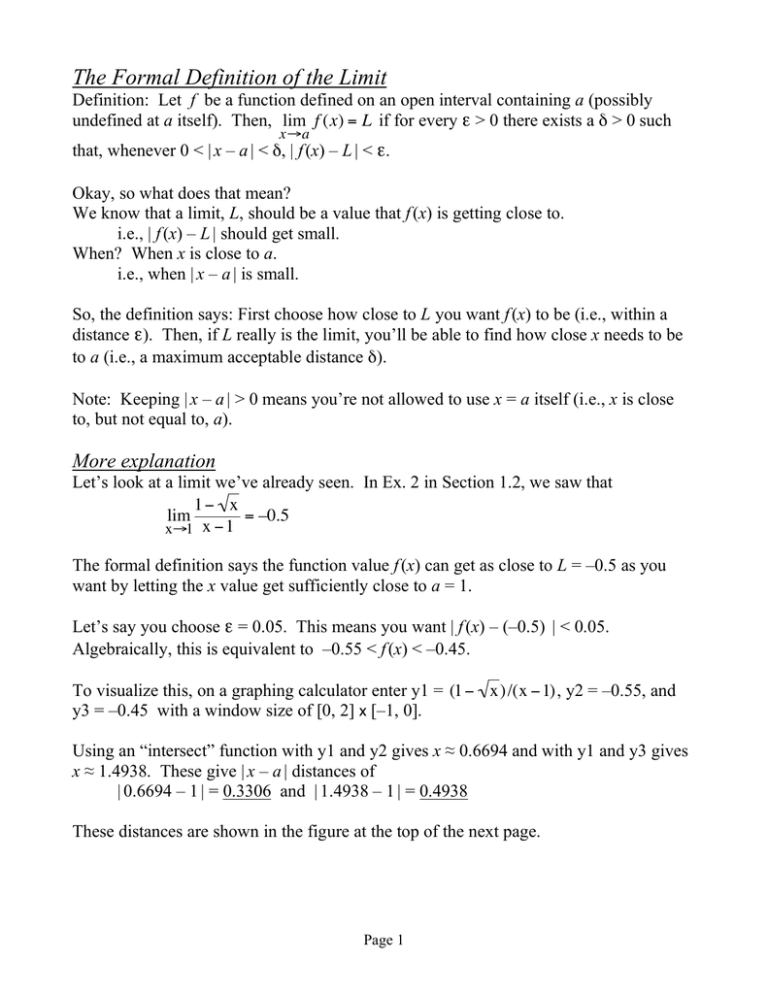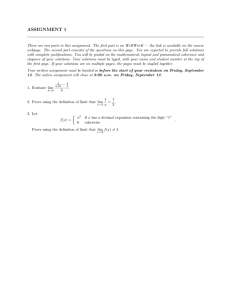The Formal Definition of the Limit
advertisement

The Formal Definition of the Limit Definition: Let f be a function defined on an open interval containing a (possibly undefined at a itself). Then, lim f (x) = L if for every ε > 0 there exists a δ > 0 such x"a that, whenever 0 < | x – a | < δ, | f (x) – L | < ε. Okay, so what does that mean? ! We know that a limit, L, should be a value that f (x) is getting close to. i.e., | f (x) – L | should get small. When? When x is close to a. i.e., when | x – a | is small. So, the definition says: First choose how close to L you want f (x) to be (i.e., within a distance ε). Then, if L really is the limit, you’ll be able to find how close x needs to be to a (i.e., a maximum acceptable distance δ). Note: Keeping | x – a | > 0 means you’re not allowed to use x = a itself (i.e., x is close to, but not equal to, a). More explanation Let’s look at a limit we’ve already seen. In Ex. 2 in Section 1.2, we saw that 1# x lim = –0.5 x"1 x #1 The formal definition says the function value f (x) can get as close to L = –0.5 as you want by letting the x value get sufficiently close to a = 1. ! Let’s say you choose ε = 0.05. This means you want | f (x) – (–0.5) | < 0.05. Algebraically, this is equivalent to –0.55 < f (x) < –0.45. To visualize this, on a graphing calculator enter y1 = (1 " x)/(x "1), y2 = –0.55, and y3 = –0.45 with a window size of [0, 2] x [–1, 0]. Using an “intersect” function with y1 and y2 gives x ≈ 0.6694 and with y1 and y3 gives x ≈ 1.4938. These give | x – a | distances of ! | 0.6694 – 1 | = 0.3306 and | 1.4938 – 1 | = 0.4938 These distances are shown in the figure at the top of the next page. Page 1 To satisfy both, I’ll choose δ = 0.33. Then | x – a | < 0.33 (i.e., 0.67 < x < 1.33) guarantees that | f (x) – L | < 0.05 What if you chose ε = 0.01? Then, y2 = –0.5 – 0.01 = –0.51 and y3 = –0.5 + 0.01 = –0.49. These gives intersection values of x ≈ 0.9231 and x ≈ 1.0833, respectively (which give distances of 0.0769 and 0.0833). To satisfy both, I’ll choose δ = 0.07. Then | x – a | < 0.07 (i.e., 0.93 < x < 1.07) guarantees that | f (x) – L | < 0.01 The definition says that, if –0.5 really is the limit L, then no matter what ε you pick, a δ can be found that works. From the graph for this example, you can see that no matter how small you make ε, you can always find a δ that will work. Now, let’s look at a case where we can see the limit does not exist: x2 + x Let g(x) = . 4x Sketch the graph on [–8, 8] x [–2, 2] and you’ll see a jump discontinuity at x = 0. From the graph, lim g(x) = –0.25 and lim g(x) = 0.25 ! x"0 – x"0+ " lim g(x) D.N.E. x#0 But, suppose I had made a mistake and thought L = 0.25. We’ll try and follow the ε-δ ! ! ! approach using the given g(x) and a = 0: Page 2 You choose ε =1. So, graph y1 = g(x), y2 = 0.25 – 1 = –0.75, and y3 = 0.25 + 1 = 1.25. Note that y1 and y2 do not intersect, while y1 and y3 intersect at x = –6 and x = 4. So, I choose δ = 4. Then | x – a | < 4 (i.e., –4 < x < 4) guarantees that | g(x) – L | < 1. Does this one ε-δ pair satisfy the conditions of the definition? NO... this needs to work for every ε. Now, you choose ε = 0.1, giving y2 = 0.15 and y3 = 0.35. (Zoom in for a better graph.) Note that y1 and y2 intersect at x = –1.6, and observe that for every x in the interval (–1.6, 0), the function is below y = 0.15. This means that | f (x) – L | > 0.1. So, no matter what I pick for δ, the interval | x – a | < δ (i.e., – δ < x < δ) will contain values of x where | f (x) – L | 0.1. This proves that 0.25 is not the limit. Given the separation in the graph at x = 0 (a vertical distance of 0.5), it seems reasonable that no matter what someone might guess for L, choosing ε = 0.1 will always lead to no possible value for δ (i.e., the limit does not exist). Page 3 Examples Using the Definition Ex 1. Use the ε-δ definition to prove that lim 2x – 5 = 1. x"3 This means that we can’t just pick a few values for ε, but instead show that it works for every ε > 0. ! We’ll start with some preliminary algebraic work: | f (x) – L | < ε ⇔ |(2x – 5) – 1| < ε ⇔ |2x – 6| < ε " ⇔ 2|x – 3| < ε ⇔ x – 3 < 2 Now we’re ready to prove the limit. # Proof: Let ε > 0. Choose " = 2 . ! " Then 0 < | x – a | < δ ⇒ x – 3 < 2 ⇒ 2|x – 3| < ε ! ⇒ |2x – 6| < ε ⇒ |(2x – 5) – 1| < ε ! ⇒ | f (x) – L | < ε (This proves the limit because it works for every ε.) Ex 2. Use the ε-δ definition to prove that lim 3 x = 0. x"0 Preliminary algebraic work: | f (x) – L | < ε " 3 x – 0 < # " 3x < # x!< # 3 " x – 0 < #3 Proof: Let ε > 0. Choose " = # 3. Then!0 < | x – a | < δ ! " x – 0 < #3 " ! ! ! ! ! " x < #3 " 3x < # " 3 x –0 < # " f (x) – L < # ! ! ! Page 4 Ex 3. Use the ε-δ definition to prove that lim 4 x 2 – 49 = –13. x"3 Preliminary algebraic work: | f (x) – L | < ε " (4 x 2 – 49) – (–13) < # " ! 2 – 9) < # 4(x " 4 x 2 – 36 < # " 4# x+ 3# x – 3 < $ # (assuming x ≠ –3) 4x+3 ! Note ! depends on x! We need a constant. ! that the right-hand side ! x–3 < " So, since we’re interested in values of x close to 3, let’s assume 2 < x < 4 ! means that δ ≤ 1. Then This 2 < x < 4 ⇒ 5 < x + 3 < 7 ⇒ 5 < | x + 3| < 7 ⇒ 20 < 4| x + 3| < 28 1 1 1 " < < 28 20 4x+3 # # " < 28 4x+3 ! $ #' Proof: Let ε > 0. Choose " = min %1, (. & 28 ) ! # Then 0 < | x – a | < δ " x–3 < and 2 < x < 4 28 # " x – 3 < ! 4x+3 " 4x+3 x–3 < # ! ! ! ! " 4 x 2 – 36 < # " (4 x 2 – 49) – (–13) < # " f (x) – L < # ! ! Page 5



